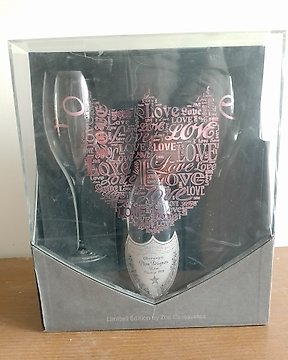
1998 Dom Pérignon, Love Edition by Zoë Cassavetes with 2 glasses - Șampanie Rosé - 1 Sticlă (0.75L)
Nr. 81768265

Nr. 81768265

Château Miraval is a wine producer in the southern French region of Provence. While it is known for its intense, flinty rosé wines made from Grenache and Cinsaut, it is perhaps better known for its association with Hollywood film stars Brad Pitt and Angelina Jolie.
The estate made simple Vin de Pays wines until the 1990s, when viticulture was modernized. Pitt and Jolie acquired the estate in 2009, and were married there in 2014.
Previously, Miraval had housed a major recording studio where the likes of Pink Floyd and Sting recorded songs – a wine was even named for the former. Château Miraval's wines are now made in partnership with the Perrin family.
The 500 hectare (1200 acre) estate features a rustic château, olive groves and a 30 hectare (74 acre) vineyard. The wines are made from a mix of estate-grown and contract-grown fruit.
Miraval makes four wines – the flagship Côtes de Provence Rosé, two white wines made from Rolle, and a red wine which falls under the Vin de France designation.
Champagne Rosé is the appellation for Champagne tinted pink by the dark pigment contained in the skins of Pinot Noir and Pinot Meunier grapes. The wines are sometimes referred to informally as 'pink' champagne.
As with the whites, rosé non-vintage and vintage Champagne (millisimé) is produced. However, not all producers make a vintage Champagne in pink, and those that do so usually limit releases to the best years. Some firms make no rosé at all, or only for specific clients. This particularly applies to smaller grower Champagne labels, and/or specialists in Blanc de Blancs.
The pigmentation is usually achieved by adding a little red wine to an existing white cuvee, with Pinot Noir being the variety that is typically employed. This method has the great benefit of allowing the cellar master to create batches of rosé according to demand.
The saignée method is also permitted under INAO Champagne production laws, although this is used less often. Here pink juice is removed from the must at an early stage, and then fermented without the skins.
The red-fruit character and earthy, meaty aromas of Pinot Noir are also detectable in rosé Champagnes. Together, these factors give the wines greater organoleptic complexity than is typically found in their white counterparts.
A typical rosé Champagne offers red fruit aromas and a subtle meaty, yeasty character. The latter results from extended lees contact and exposure to the Pinot grape skins. Although more usually consumed as a celebratory drink – not accompanied by food – rosé Champagne is versatile; its fuller flavor and body enable it to cope with stronger food flavors and textures. Bold acidity and forward fruit aromas make it a good match for simple grilled seafood, roast pork or even more exotically spiced dishes.
Although there is variation in the sweetness levels, the wines are most often dry (brut or sec) in style. The recent trend towards zero dosage or extra Brut white Champagne has seen the introduction of a few very dry examples but the style has not caught on widely. There is certainly a marked difference between a dry rosé Champagne and the sweet pink wines of Bugey-Cerdon or the central Loire Valley.
Rosé Champagne is subject to changes in fashion, as well as higher prices as a result of its perceived exclusivity. Most of the top Champagne houses have a rosé wine in their portfolios; the most widely known examples are perhaps those by Laurent-Perrier, Billecart-Salmon, Ruinart and Veuve-Clicquot.
At the very top of the market, Krug, Dom Perignon and Louis Roederer Cristal are mong the most highly priced bottlings. On the other hand, Bollinger did not release a rosé until the late 1970s, when Bollinger Grande Année Rosé was first produced. This was a full 150 years after the company was founded.
Cum să cumperi de la Catawiki
1. Descoperă ceva special
2. Plasează cea mai mare ofertă
3. Fă o plată sigură